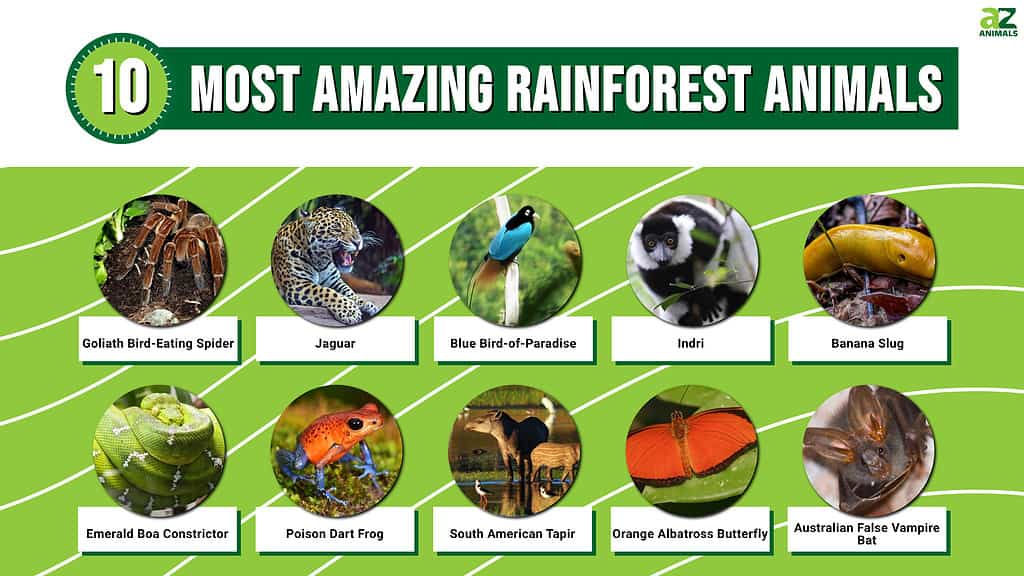
A rainforest is defined as a forest where rainfall is abundant and even continuous. A tropical rainforest would get between 96 and 177 inches every year. The amount of rainfall in a temperate rainforest isn’t so well defined, but the rainfall must still be heavy. Definitions may also include the density of the tree canopy and plants that don’t need fire for their seeds to germinate. In any case, rainforests are the habitat of much of the world’s flora and fauna, some of whom are rare or even undiscovered. With that in mind, here are 10 amazing animals that live in rainforests around the world:
#10. Amazing Rainforest Animal: Australian False Vampire Bat
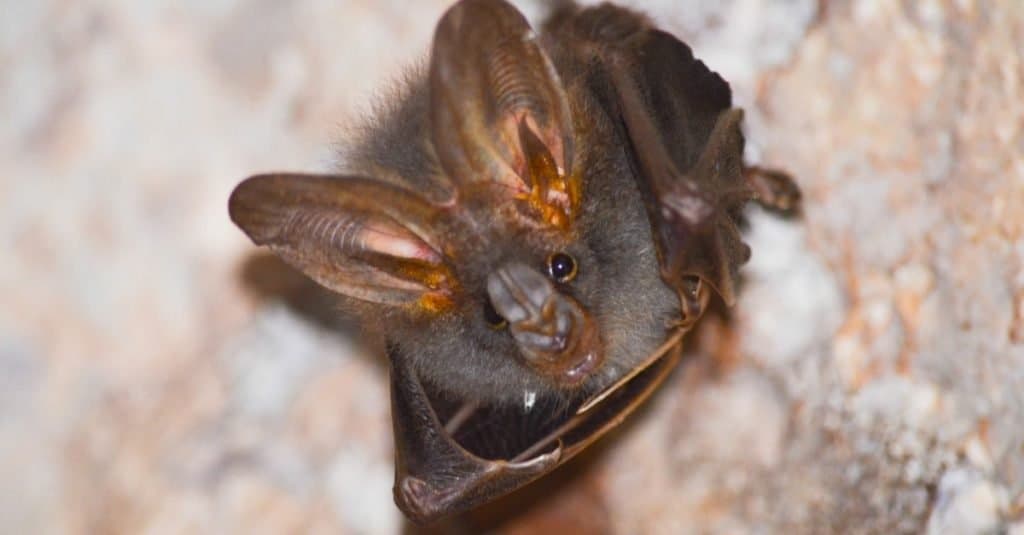
©Visanuwit thongon/Shutterstock.com
Also called the ghost bat, this flying mammal is only found in Australia and lives in the north Queensland rainforest where it shelters in crevices and old mines. Because its habitat is being destroyed, it is rare to find very large colonies of these bats. The animal has a body length of between 4.53 o 5.12 inches and weighs between 4.58 to 5.99 ounces. It has a nearly 20-inch wingspan and a distinctive nose leaf. Its fur is silvery, which gives it its name of ghost bat.
One thing that makes this animal unique among Australian bats is that it’s a carnivore. It eats reptiles, birds, smaller mammals, frogs, and insects. It isn’t above eating other bats. It devours the entire animal, including bones, teeth, fur, and feathers. In general, the “false vampire bat” family gets its name for the fact that they were once thought to be vampire bats, feeding on the blood of other animals. But they were later found to be bats that eat the entire bodies of their prey.
#9. Amazing Rainforest Animal: Orange Albatross Butterfly

©Kiki Dohmeier/Shutterstock.com
The wing color of the male of this large butterfly is unique, for it seems to be the only butterfly in the world with wholly orange wings. The wings of the females are also orange, but they have black bands and a black border. Females tend to stay in the canopy of the forest while the males can be seen puddling in damp rivers and stream banks.
The orange albatross has a wingspan of between 2.25 and 3 inches and sips nectar from a variety of tropical plants. The caterpillar uses caper plants as hosts. The orange albatross is found in the rainforests of Northern India and eastward to Malaysia, Sulawesi, and the Philippines.
#8. Amazing Rainforest Animal: South American Tapir
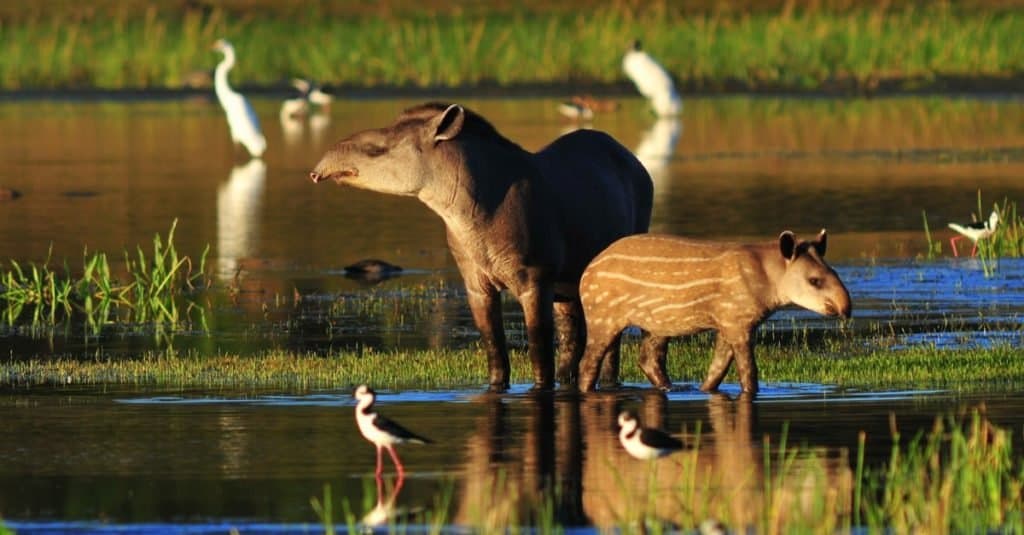
©Lucas Leuzinger/Shutterstock.com
Native to the rain forests of Central and South America, the South American tapir is the largest extant terrestrial mammal found in the Amazon. Its body, covered in dark brown hairs, ranges in length from 5.9 to 8.2 feet and stands between 30 to 43 inches high at the shoulder. The animal can weigh as much as 496 pounds though it can be as heavy as 710 pounds. The tapir has a prehensile nose that allows it to pull leaves, buds, shoots, and fruit from trees. The animal’s size makes it prey for only the biggest and most aggressive predators such as crocodiles and jaguars. A good swimmer, a tapir lives between 25 and 30 years.
The South American tapir is a herbivore and enjoys a breeding period in the spring. After a pregnancy of about 13 months, the female tapir gives birth to a 15-pound baby with a brown coat streaked with white. The South American tapir is considered vulnerable. It can be found in the Barcelona Zoo, the Litchfield Park Zoo, and the Gdański Ogród Zoologiczny.
#7. Amazing Rainforest Animal: Poison Dart Frog
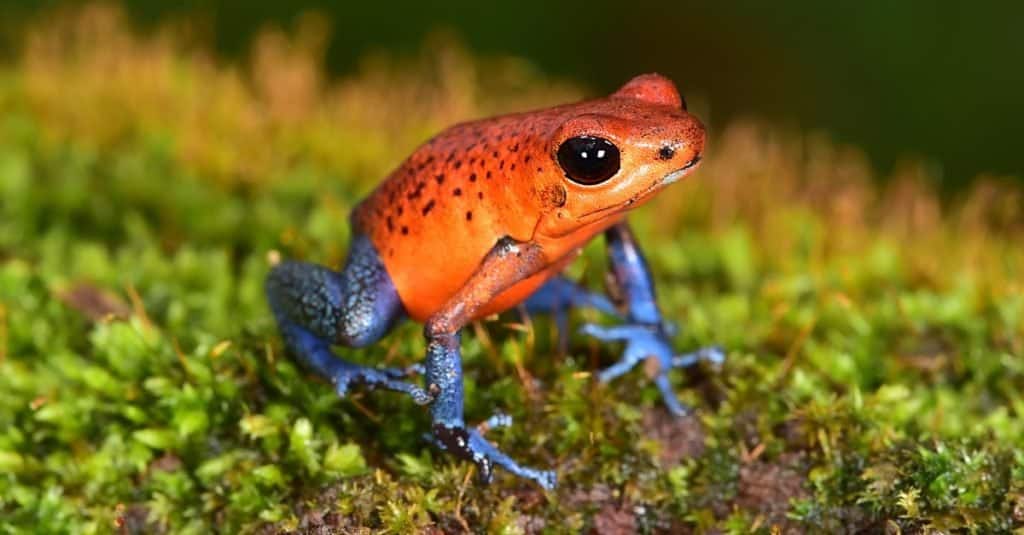
©worldswildlifewonders/Shutterstock.com
Poison dart frogs are tiny and come in vivid, jewel-like colors. Many, but not all are dangerous to even handle thanks to the potent venom in their skin. They’re found in the rainforests of Central and South America and get their name because Native Americans used to dip the tips of their darts into their skin to make their weapons more lethal. The frogs used for this were all members of the Phyllobates genus.
The bright colors of these frogs warn potential predators of their toxicity. The toxins don’t arise in the frog naturally but come from the ants and termites that they eat. Poison dart frogs lay their eggs in places where there’s at least a little moisture, such as leaves after rainfall. When the tadpoles hatch out often eggs, the adult carries them one by one to a body of water, even one found in the cups formed by bromeliad leaves. The mother may even give the tadpole unfertilized eggs to eat until it undergoes a metamorphosis.
#6. Amazing Rainforest Animal: Emerald Boa Constrictor

The Emerald boa constrictor is also known as the green tree boa. They catch most of their prey while they hang from a branch to snatch them off the ground.
©Hannamariah/Shutterstock.com
The beautiful emerald boa constrictor also called the emerald tree boa gets its name from its bright green coloration, which is unique among the snakes of South America. The green scales have white broken stripes that resemble lightning bolts. Juveniles are red or orange before they take on the vibrant green color between the ages of nine and 12 months.
The snake, which can grow to 6 feet in length, is found in northern South America and eats small mammals, birds, frogs, and lizards. Because of its slow metabolism, the emerald boa doesn’t need to feed that often and can stay healthy even if it doesn’t eat for months. The snake is nonvenomous but has well-developed front teeth that can probably deliver a memorable bite.
The emerald boa constrictor is found in the Brevard Zoo, the Dallas World Aquarium, the San Diego Zoo, and the Beardsley Zoo among others.
#5. Amazing Rainforest Animal: Banana Slug

©MC Creative/Shutterstock.com
Not all rainforests are tropical. The Hoh Forest found in Washington state in the United States is a temperate rainforest, and one of its most famous denizens is the banana slug. As its name suggests, the banana slug is often bright yellow, but it can also be green, white, or shades of brown. These slugs also change colors according to their environment and their health.
The Pacific banana slug, which is found in the Hoh forest, can grow to nearly 10 inches long and weigh a quarter of a pound. It’s also long-lived for a slug and can live as long as 7 years.
#4. Amazing Rainforest Animal: Indri
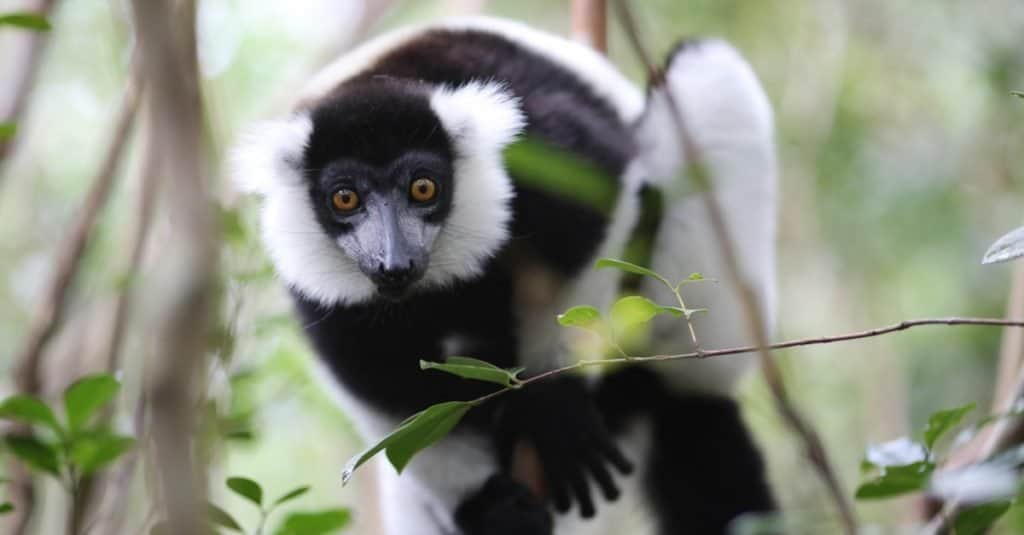
©Iryna Art/Shutterstock.com
The indri or babakoto is a critically endangered lemur and so is native to Madagascar. It is in fact the largest lemur and has a body length of 23.5 to 28 inches and a weight of between 13 and 21 pounds. This animal has a woolly black coat with white patches found on the arms, the legs, and the back of its head and neck, though the face is naked and its skin is black. The staring eyes are green, and the ears have black tufts.
The indri is a herbivore that eats leaves, seeds, flowers, and fruit and lives in family groups. It is monogamous and will only seek another mate if its original mate dies, and family groups are made up of the couple and their children or even grandchildren. Females dominate the males, and the alpha female leads the group as it forages among the trees. The indri is known for its vocalizations, which can be roars, wails, honks, wheezes, and hums.
The indri is revered as an ancestor by the Malagasy people, and hunting it is taboo. Still, its numbers are declining due to habitat fragmentation and poaching.
#3. Amazing Rainforest Animal: Blue Bird-of-Paradise

©gailhampshire from Cradley, Malvern, U.K / CC BY 2.0, via Wikimedia Commons – License
This stunningly beautiful bird is found in the rainforest of eastern New Guinea. It’s found in the foothills of the mountains. Females and juveniles form flocks, but adult males are usually solitary. He has a black head with eyes ringed in white, a velvety blue back, and colorful flank plumes. His tail filaments are what make him unique. At 13.5 inches long, they are longer than the bird’s 12-inch long body and end in tiny spatulas.
The male bird uses this equipment to impress the females in an amazing upside-down courtship dance, all the while making a metallic noise that makes him sound like a wind-up toy. If the female accepts the male, they’ll mate, and she’ll go away to build a nest and lay one or two eggs. The male goes on to woo yet another female.
#2. Amazing Rainforest Animal: Jaguar
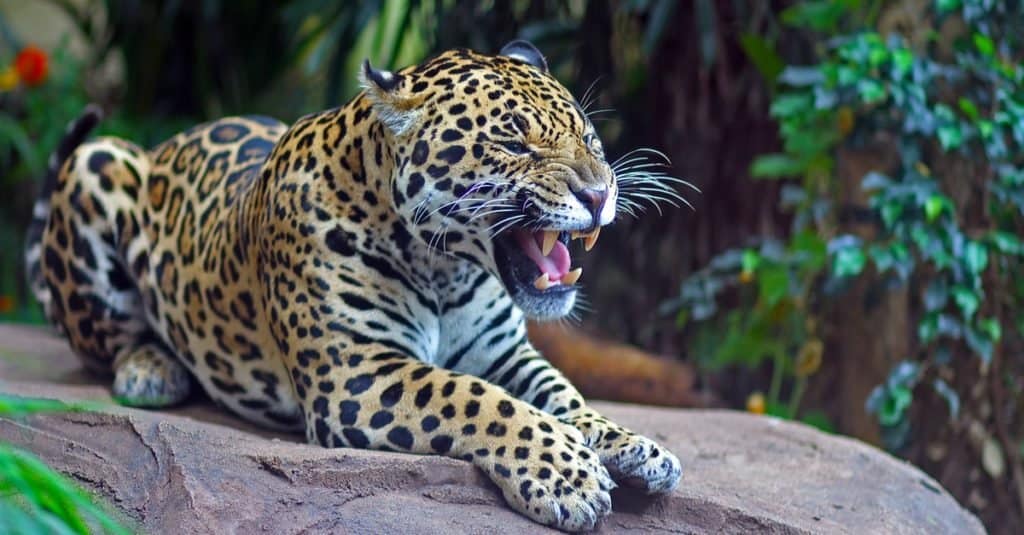
‘.
©GoWildPhotography/Shutterstock.com
The amazing, powerful jaguar is the largest wild cat in the New World. A jaguar can be 6.25 feet long, excluding the tail, and weigh as much as 350 pounds. It can be mistaken for a leopard, but it is bigger and stockier and has a shorter tail. Instead of individual spots, it has a pattern of attractive rosettes on much of its body, and spots along its backbone may merge to form a single dark line.
Black jaguars aren’t as rare as some think, and their spots can be detected if a light is focused on the animal’s coat. The jaguar not only lives in the rainforests of Central America and northern South America, but it lives close to bodies of water in these forests and knows how to swim.
Despite efforts to protect it, the jaguar is considered near threatened due to persecution and habitat destruction. Jaguars can be found at the San Diego Zoo, the Stone Zoo, the LA Zoo, the Houston Zoo, and the Phoenix Zoo.
#1. Amazing Rainforest Animal: Goliath Bird-Eating Spider
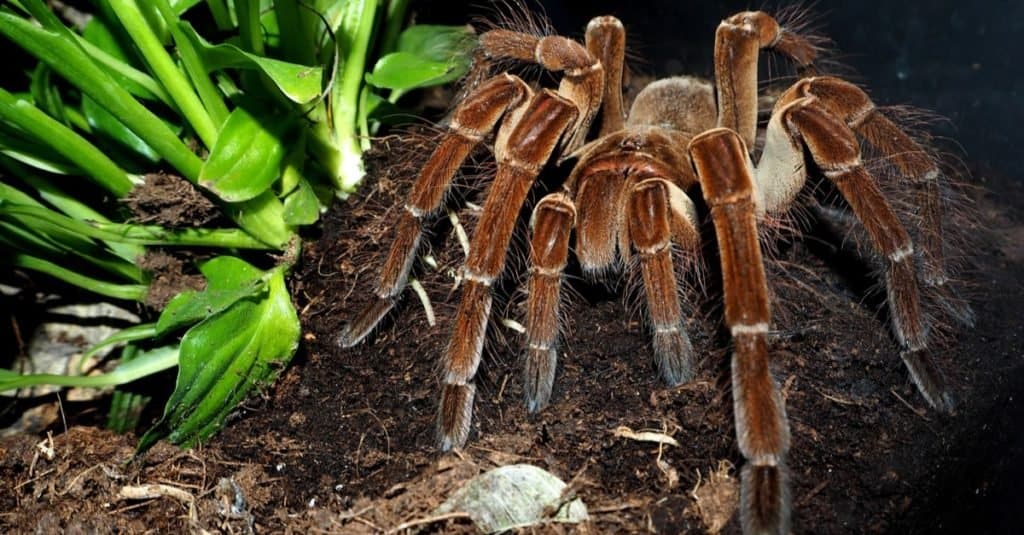
©NataliSel/Shutterstock.com
Despite its name, incidents of this spider in the northern South American rainforest catching and eating birds are rare. However, the Goliath part of its name is accurate because it is huge. Only Australia’s huntsman spider has a longer leg span. The Goliath birdeater can weigh as much as 6.02 ounces, have a body that’s 5 inches long, and a leg span that’s almost a foot wide. Its fangs are formidable at 1.57 inches, but its venom is fairly harmless to humans. Sometimes, the spider doesn’t inject venom at all when it bites.
The bodies of the Goliath bird-eating spiders are hairy, and the hairs range in color from tan to golden. Females live much longer than males. A female can live as long as 25 years, but males only live between three and six years even though the females don’t kill and eat them after they mate as other tarantulas do. After mating, she’ll lay between 100 and 200 eggs, and they’ll hatch in a month and a half to two months.
Summary of the 10 Most Amazing Rainforest Animals
Let’s take a peek back at some truly amazing animals that dwell in the world’s rainforests:
| Rank | Rainforest Animal | Type of Animal |
|---|---|---|
| 1 | Goliath Bird Eating Spider | Insect |
| 2 | Jaguar | Mammal |
| 3 | Blue Bird-of-Paradise | Bird |
| 4 | Indri | Primate |
| 5 | Banana Slug | Insect |
| 6 | Emerald Boa Constrictor | Reptile |
| 7 | Poison Dart Frog | Amphibian |
| 8 | South American Tapir | Mammal |
| 9 | Orange Albatross Butterfly | Insect |
| 10 | Australian False Vampire Bat | Mammal |
The photo featured at the top of this post is © mark higgins/Shutterstock.com
Thank you for reading! Have some feedback for us? Contact the AZ Animals editorial team.






